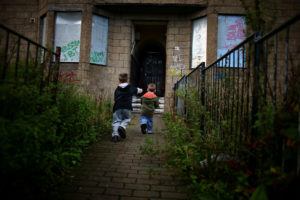There is arguably one unifying theme which connects many of Britain’s current difficulties — proximity. From wealthy politicians tackling poverty to drug counsellors who’ve never smoked a joint, Britain is riddled with problems of proximity across its key institutions and at every level of governance.
We elect politicians to advance our interests. But to advance the interests of any group, one must first understand something of those interests. How many MPs have experienced poverty? How many have had their toilet breaks timed or their in-work benefits slashed?
At what point do we look for the root of Britain’s problems not in the lifestyle choices, attitudes, and behaviours of working people, and the poor and the vulnerable, but in the groundless assumptions, false beliefs, and prejudices of the apparently educated, cultured and sophisticated?
If the pandemic brought one thing into focus, it was surely that “social distancing” — that is, the vast ravine of social experience between those who hold power and influence and those on the receiving end of their decisions — brought Britain to its knees long before the pandemic.
The links between social deprivation and health problems are well understood. We’ve known for the best part of 40 years that rapid deindustrialisation was a public health time-bomb — we chose not to act.
In the Eighties, the publication of the infamous Black Report — commissioned in 1977 by the previous Labour government to investigate health inequalities — found significant differences in health outcomes between the social classes in both sexes and all age groups. The report’s introduction stated: “Social class differences and mortality begin at birth. In 1971, neonatal death rates (deaths within the first month of life) were twice as high for the children of low skilled workers as they were for the professional classes.”
The Thatcher government did all it could to suppress this report’s findings. Sir Douglas Black’s recommendations — that social inequalities around death and ill-health had to be confronted seriously by raising child benefit, improving housing, and agreeing minimum working conditions with unions — were dismissed before being kicked into the political long grass.
The trends already set in motion when the Black Report was published accelerated and became simply undeniable during the pandemic, demonstrated by the disproportionate impact of Covid on working people and the poor.
In the post-industrial community of Possil, north-west Glasgow, the impact of this health gap is both ubiquitous and imperceptible, so adjusted have its residents become to falling ill and seeing loved ones taken before their time, while public officials scratch their heads, puzzled as to why these people can’t just get it together.
As dusk falls at around 5pm, the two local pubs are already busy. Some are keener to talk than others but every person I speak to is managing at least three concurrent and chronic health conditions — known as multimorbidity in the medical profession.
Previously associated with the elderly, multimorbidity is beginning to impact people at a much younger age. In the pub, half of the patrons enjoying an afternoon tipple are afflicted by mobility issues. Two have trouble speaking due to respiratory problems. One has a degenerative brain disorder and struggles to stay in the conversation, while his long-suffering son (and designated driver) brings him another half.
One man, Andy, tells me about his first health scare at the age of 29. Despite his healthy glow, he has suffered four subsequent heart attacks since the first. Once a keen marathon runner, Andy is now restricted in his lifestyle and stands out today because he is the only person in the pub who is not drinking. He is here to spend time with his friend, who sits adjacent, panting, his crutches rested against the table, sporting the haunted expression of a man who knows his next breath may be his last; Andy’s company, I’m positive, is most welcome.
Andy shares a worrying (and hilarious) story about his fourth heart attack, which he had in his home around the corner from the pub. Given his relative experience of cardiac arrests and his disinterest in going to casualty — where he was convinced doctors wouldn’t believe him — he decided simply to wait it out in his home until morning, before going to see a GP whom he trusts.
That GP was Dr Lynsay Crawford, who has worked in areas like this for most of her career. “There’s a fatalistic attitude,” she said. She described an interaction with a patient who was weighing up the pros and cons of making a dramatic lifestyle choice to prevent an early death. “I remember chatting and they said, ‘My life’s rubbish, I know if I did all these things, I’d live longer but I really don’t want to live a longer rubbish life,’” she laughed. “You’ve got a fair point my friend, my work here is done,” she joked. “Another therapeutic success!”
This levity, which arose from the close proximity Lynsay had to her patients, contained a healing quality of its own. She took the time to get to know them, their conditions and idiosyncrasies so well that cracking a joke, or shooting from the hip when someone requires some tough love, was a matter of instinct. I was deeply moved by her devotion to this resilient but challenged community — and how loved she was by those under her care.
Sadly, Lynsay no longer works at the local practice. Due to the work-related stress and the effect on her home life, she moved on. After years of trying to communicate the impact of poor healthcare provision on both patients and the local practice, she became resigned to the fact nothing would change — much like her patients in the face of their ailments.
What chance do communities like Possil have when resources are so scant that even doctors who love the areas in which they work, and understand them intimately, feel they have no choice but to practise medicine elsewhere or risk their own health and wellbeing?
“We can’t get doctors to come and work in deprived areas,” she explained, “so if you’re living here, you might have to wait weeks to see a GP — who’s got ten minutes to see you.” Lynsay identifies funding as the central issue. Specifically, the disproportionate levels of funding granted to affluent communities, where health problems are fewer.
It’s in these conditions that some people simply stop contacting the doctor’s surgery and instead self-medicate at one of the numerous local pharmacies, where codeine-infused, highly addictive painkillers, sleeping medications and potent cough mixtures are advertised prominently in the windows and are readily available without prescription. It is also in these conditions that toothaches become abscesses requiring emergency surgery; aches and pains become chronic mobility issues; strange lumps, put quickly out of mind, become stage four cancers and mental health problems and addictions become drug deaths and suicides.
“The disconnect is definitely with those who make policy,” Lynsay tells me. She believes the NHS alone cannot resolve health inequalities because they are caused by wider social issues, like education, unemployment, and housing, but that the lack of funding to the NHS over the last decade has exacerbated many of the long-term issues, leaving different factions within the NHS fighting over the same dwindling pot of money.
Lynsay questions the wisdom of splitting resources equally among all practices regardless of need and believes this funding formula is why the gulf between social classes with respect to health is widening. “The overwhelming body of evidence shows those in poorer communities have worse health (at a younger age too) and have a greater need for funding to reduce health inequalities. It is clear that equal distribution of funding is leading to greater inequality.”
Despite people from poorer backgrounds requiring more healthcare than those in more affluent communities, they receive less. Wealthier patients’ health problems tend to be less complex — multimorbidity and poverty are synonymous — requiring less time to explain during a consultation, yet they may receive, on average, a minute or so longer with their physicians than someone from a poorer area. Analysis from the Health Foundation in 2020 found that patients in the richest areas receive 11.2 minutes on average while those in the most deprived communities get 10.7 minutes. This is not an anomaly. This imbalance is written into health systems and is known in the field as the “inverse care law”.
This is a community defined culturally by its poverty-induced health and social problems. For every heart attack, stroke, drug death, murder, and suicide there are countless family and friends on the periphery who must absorb the loss of a loved one while trudging on with their own challenging lives. Here, everyone is mourning a loss of some kind.
The lifestyle so often associated with people who live in post-industrial communities like this — overeating, excessive drink and drug use, gambling — provides temporary comfort and fleeting familiarity and continuity in what can be a chaotic, deeply disheartening, and tough existence. Many adopt fatalistic attitudes towards their own health because it’s a way of exerting control over external and internal circumstances they understandably feel are beyond them.
In areas like Possil, across the UK, people in most need of care are simultaneously the most distant from the health services that could improve or save their lives. Life expectancy for men is 66 and for women is 73 — though both sexes have the lowest life expectancy of all neighbourhoods in this city. The number of people hobbling around on walking sticks, frames, wheelchairs, or mobility scooters is astounding.
Meanwhile, politicians in charge of the purse strings, keen to remain in the good graces of the middle classes, are far too attuned to their own short-term electoral interests, at the expense of longer-term health equality. And every time they act in those interests, thus postponing confrontation with the reality that wealthier citizens hoard too many resources, poorer people fall ill and die.
But perhaps the most shocking aspect in the ongoing public health debate, so often centred on notions of individual responsibility rather than systems which demonstrably favour wealthier citizens, is how distant most people remain from the ugly, irrefutable truth: poor health is absolutely a choice — a political one.
Extracted from The Social Distance Between Us: How Remote Politics Wrecked Britain by Darren McGarvey, published by Ebury Press on 16th June at £20.00 Copyright © Darren McGarvey 2022
Disclaimer
Some of the posts we share are controversial and we do not necessarily agree with them in the whole extend. Sometimes we agree with the content or part of it but we do not agree with the narration or language. Nevertheless we find them somehow interesting, valuable and/or informative or we share them, because we strongly believe in freedom of speech, free press and journalism. We strongly encourage you to have a critical approach to all the content, do your own research and analysis to build your own opinion.
We would be glad to have your feedback.
Source: UnHerd Read the original article here: https://unherd.com






